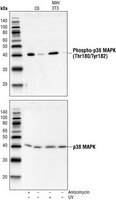506123 Sigma-AldrichAnti-p38 MAP Kinase (341-360) Rabbit pAb
This Anti-p38 MAP Kinase (341-360) Rabbit pAb is validated for use in Flow Cytometry, Immunoblotting, Paraffin Sections for the detection of p38 MAP Kinase (341-360).
More>> This Anti-p38 MAP Kinase (341-360) Rabbit pAb is validated for use in Flow Cytometry, Immunoblotting, Paraffin Sections for the detection of p38 MAP Kinase (341-360). Less<<お勧めの製品
概要
| Replacement Information |
|---|
主要スペック表
| Species Reactivity | Host | Antibody Type |
|---|---|---|
| H, M, R | Rb | Polyclonal Antibody |
価格&在庫状況
| カタログ番号 | 在庫状況 | 包装 | Qty/Pk | 価格 | 数量 | |
|---|---|---|---|---|---|---|
| 506123-200ULCN |
|
樹脂アンプル | 200 ul |
|
— |
| Description | |
|---|---|
| Overview | Recognizes the ~38 kDa p38 MAPK protein.
|
| Catalogue Number | 506123 |
| Brand Family | Calbiochem® |
| Application Data |  Detection of p38 MAP kinase by immunoblotting. Samples: C6 cells (lanes 1 and 2) treated (lane 1) or untreated (lane 2) with anisomycin and NIH/3T3 cells (lanes 3 and 4) treated (lane 3) or untreated (lane 4) with UV. Primary antibody: Anti-p38 MAP Kinase (341-360) Rabbit pAb (Cat. No. 506123) (1:1000). Detection: chemiluminescence. |
| Product Information | |
|---|---|
| Form | Liquid |
| Formulation | In 150 mM NaCl, 10 mM HEPES, 50% glycerol, 0.01% BSA, pH 7.5. |
| Preservative | None |
| Quality Level | MQ100 |
| Physicochemical Information |
|---|
| Dimensions |
|---|
| Materials Information |
|---|
| Toxicological Information |
|---|
| Safety Information according to GHS |
|---|
| Safety Information |
|---|
| Product Usage Statements |
|---|
| Packaging Information |
|---|
| Transport Information |
|---|
| Supplemental Information |
|---|
| Specifications |
|---|
| Global Trade Item Number | |
|---|---|
| カタログ番号 | GTIN |
| 506123-200ULCN | 04055977199475 |
Documentation
Anti-p38 MAP Kinase (341-360) Rabbit pAb (M)SDS
| タイトル |
|---|
Anti-p38 MAP Kinase (341-360) Rabbit pAb 試験成績書(CoA)
| タイトル | ロット番号 |
|---|---|
| 506123 |
参考資料
| 参考資料の概要 |
|---|
| Raingeaud, J., et al. 1995. J. Biol. Chem. 270, 7420. Zervos, A.S., et al. 1995. Proc. Natl. Acad. Sci. USA 92, 10531. Han, J., et al. 1994. Science 265, 808. Lee, J.C., et al. 1994. Nature 372, 739. Rouse, J., et al. 1994. Cell 78, 1027. |











